Sandwich bottom
Higher heat conductor, Heat retention, careful not to apply heat beyond the disk as it will begin to torch the sides and wear down the pan.
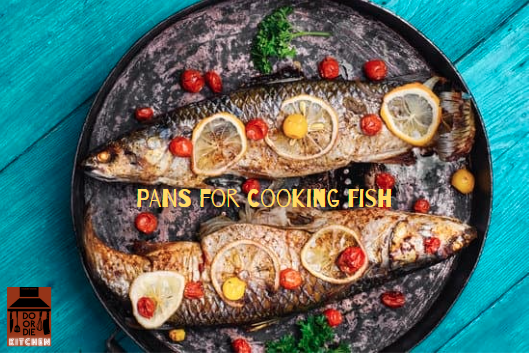
Do or Die Kitchen is a participant in the Amazon Services LLC Associates Program, an affiliate advertising program designed to provide a way for websites to earn advertising revenues by advertising and linking to Amazon.com
Table of Contents
Overview
In this article we list ten highly rated pans for cooking fish with a price tag of $25 or less, that have been tested and approved by our team. Having the right tools in your kitchen will greatly impact the overall quality of your food and cooking experience. Each cookware item was judged using the following criteria:
Material: When it comes to pans not all material is created equal. Depending on the make of your pan will determine a variety of things. How evenly your fish cooks, its crispness, moisture, and so on. Depending on the occasion or just your preference, the type of pan you choose for cooking your fish is going to make all the difference.
Heat Conduction: How heat is transferred to your food will impact the end product in either a very good or a not so good way. You want your pan(s) to have the ability to evenly transferred the right amount of heat to your food, especially when preparing the meatier varieties such as trout, tuna, yellowtail, bluefish, tilapia or salmon.
Reactivity: A reactive pan is simply referring to its response to highly acidic foods. Such foods include citrusy products, tomatoes and some wines. One of our favorite types of cookware, cast iron, especially falls into this category. The downside to reactive cookware is the resulting metallic taste that comes from the clash of acidity and “reactive” metal. Metallic tasting food is no fun for anyone! There are a couple workarounds discussed later in this article, that can help reduce and sometimes prevent the transfer of metallic taste to your food.
Maintenance: Although maintenance doesn’t fall super high on our list, it is something to consider depending on the individual and your kitchen situation. The questions we ask are; how easily can it be cleaned? Is it dishwasher safe? How durable is it? A Pan that is easily cleaned, sturdy and flexible always makes life easier for the cook.
Safety: In terms of safety there are several things we took into consideration. First we looked at the handle and how it’s attached to the pan (more below under “Types of Pan Handles”). We don’t advise using pans with screw-in handles, as the handle can become loose overtime, creating a prime opportunity for an accident.
Also, handles angled at a 45 degree angle with cutout vents provide an immense amount of safety and stability. Firstly, when angled in such a way it allows for more room for other pots and pans, this is especially important when cooking multiple things on your stovetop at once. Secondly, the cutout vents are designed to reduce heat transfer between the pan and the handle, reducing the risk of a hand burn. Please note, even with cutout handles you should get in the habit of using a glove or towel when working with hot pans.
Durability & Versatility: Lastly we looked at how much punishment a pan can take before beginning to breakdown. The “breakdown” of a pan can be anything from discoloration, warping or getting scratched up. Of course with any pan if you’re unnecessarily rough on it the natural conclusion will be for it to breakdown faster. You want to take care of your cookware in a way that helps maintain its structure and overall quality. This includes properly cleaning (more below), limited exposure to high heat and harsh utensils and not using for storage.
Rating: Each pan was rated on a scale from “1” to “5”, with five stars being the “best”. The more a pan checked out in each area the higher its ranking.
Firstly, we love the look. Although the handle isn’t at a forty-five degree angle, it’s still well placed and compliments the pan very well. The smooth finish feels amazing to the touch and you will find yourself gazing at it for a while before putting it to the flame.
Overall Rating: ★★★★★
This pan’s overall quality and safety met or exceeded our expectations in most instances. Below you will find a breakdown of each category and how they were scored.
Heat Conduction: ★★★★★
Whether low or high heat we were impressed by how evenly this pan cooks fish. The handle didn’t become extremely hot, although you could feel some warmth, but not to the point of being unbearable. For this reason this pan receives 5 stars for heat conduction.
Reactivity: ★★★★★
This pan is completely non-reactive.
Maintenance: ★★★★★
This pan was very easy to clean, any mess left in the pan slid right off with little effort. Plus this pan is dishwasher safe. We ran it through the dishwasher at least twice with no resulting damage or changes.
Safety: ★★★★★
There are several factors that makes this pan extremely safe and trustworthy. Firstly the construction is solid, the handle is well fastened and easy to grip. This is so important when working with superhot metal and food. It can even be placed inside the oven and is capable of tolerating up to 600°F, not bad! Most importantly it is toxin free. This product is free of PFAS, PFOA, Lead and Cadmium (more on the horrific effects of these toxins below - For your safety please read!!!).
Durability & Versatility: ★★★★★
The first thing I noticed when holding this pan was it’s firmness. You can feel the quality when you hold it and you wonder how such an amazing pan can go for so cheap! After multiple uses this pan is showing no signs of wearing down.
Best For:
This pan heats up quickly and does well producing a nice even finish while maintaining a juicy succulent inside. In our finding we identified the following fish as good options to cook using this pan. While we did not cook all of the fish below using this pan, they all share similar properties that make them a good fit for a nonstick option. The varieties below are all known for being very oily, and with a nonstick surface things will go a lot smoother during and after the cooking process.
Overall Rating: ★★★
This griddle is pretty impressive. Each time we used it I was taken back by the fact that it cost less than $25. There are two things that you must be ready for when using cast iron to prepare your fish. The first is to expect some sort of mess to cleanup, and the second is to expect some of the most amazing fish you’ve ever tasted!
Heat Conduction: ★★★★
The heat distribution was pretty impressive, although I will say the more area the flame is able to connect with the better. Overall we were impressed by this products ability to heat up quickly and stay hot.
Reactivity: ★
Cast iron, by nature, is a reactive metal. There are ways in which people go about reducing reactivity such as coating with oil and cooking in the oven, or setting upside down inside an oven and run on self-cleaning. While these options don’t offer a foolproof solution, they have been known to work well. We did not conduct such tests on this particular pan but have done so in the past and without a doubt it does help.
Maintenance: ★★★
Regardless of the brand or “quality” of a cast iron pan you will find yourself dealing with the same challenges when it comes to maintenance. Although I don’t consider cast iron pans difficult to maintain, they can be hard to clean at times. Understanding your pans is key to providing the very best care possible based on their makeup.
Safety: ★★★★
This pan is free of PTFE and PFOA toxins. Please note that by using cast iron products to prepare your food you are exposing yourself to iron that will no doubt enter your food and ultimately your body. For men and post-menopausal women this can lead to iron toxicity due to a lack of replenishment of blood in their bodies.
Durability & Versatility: ★★★★★
Cast iron pans are known for their durability and versatility. They can go from the stove top to the oven without a problem.
Best For:
Cast iron pans are the go-to when it comes to searing fish into the most delicious state. We recommend the following types of fish for cast iron cooking.
These fish are naturally thicker and hold together better under searing. Other types of fish can be seared as well but should be flipped sooner.
Overall Rating: ★★★★
Sauteing your fish is one of the best ways to maintain moisture and retain flavor. While I have my doubts about its durability over the long-term, for the price you cannot beat it!
Heat Conduction: ★★★★★
This well designed sauteing pan definitely passes the test for heat conduction. Each time used the fish was cooked evenly throughout.
Reactivity: ★★★★★
The nonstick properties of this pan allows for a nonreactive surface.
Maintenance: ★★★★★
Due to its nonstick surface it’s quite easy to clean. Please note that this particular pan is handwash only.
Safety: ★★★★
One of my favorite parts of this pan is the handle. It made for easy handling and was especially nice because my hands are pretty big. While the handle isn’t angled at my preferred forty-five degree angle, does have a slight ten degree angle which is better than nothing.
Durability & Versatility: ★★★
Whether you’re working with a gas, manual or an electric stovetop, this pan delivers a consistent product that is respectable by even the harshest of critics. I will say that although this pan is new and we expect the first few burns to favor the cook, I have my suspicions how it may fair in the long-run as far as maintaining its frame is concerned. I’ve worked with enough pans over the years to have a pretty good idea as to what I can expect long-term.
Best For:
Overall Rating: ★★★★
Grill pans are fun for a variety of reasons. One; they do an excellent job retaining flavor throughout the cooking process and two; they have the ability to make any cook look like a pro. Great for cooking all types of fish and truthfully it’s hard to get it wrong with a good grill pan.
Heat Conduction: ★★★★★
This particular model is equipped with a clad constructed bottom, allowing for superior heat distribution.
Reactivity: ★★★★★
The nonstick properties of this pan allows for a nonreactive surface.
Maintenance: ★★★★★
Due to its nonstick surface it’s quite easy to clean, whether by hand or dishwasher.
Safety: ★★★
This product is listed as PFOA free. Another thing to mention is this product has a detachable handle. While convenient such handles tend to lose integrity over time and this can present a potentially situation while cooking. I will say that the handle itself feels pretty sturdy and should last a good while.
Durability & Versatility: ★★★★★
This pan can be used on both stove top and inside the oven (up to 480°F).
Best For:
Overall Rating: ★★★
Cast iron is one of the very best options when it comes to cooking fish. The quality and taste is second to known and personally it’s the reason I was able to go from hating to loving fish.
Heat Conduction: ★★★★
Considering its density, cast iron is appreciated for its ability to heat up quickly and stay hot. For that reason it makes a wonderful companion for preparing your fish.
Reactivity: ★
Cast iron, by nature, is a reactive metal. There are ways in which people go about reducing reactivity such as coating with oil and cooking in the oven, or setting upside down inside an oven and run on self-cleaning. While these options don’t offer a foolproof solution, they have been known to work well. Like our other cast iron selection we did not test this particular pan, however, having done so in the past I can say that it can make a difference.
Maintenance: ★★★★
Cleaning cast iron is pretty straightforward. A little elbow grease is required and you should always allow time for it to cool down before washing.
Safety: ★★★
This pan is free of PTFE and PFOA toxins. Please note that by using cast iron products to prepare your food you are exposing yourself to iron that will no doubt enter your food and ultimately your body. For men and post-menopausal women this can lead to iron toxicity due to a lack of replenishment of blood in their bodies. Cast iron handles should always be handled with gloves or towel, as they can become very hot in the cooking process.
Durability & Versatility: ★★★★★
Cast iron pans are known for their durability and versatility. They can go from the stove top to the oven without a problem.
Best For:
Cast iron pans are the go-to when it comes to searing fish into the most delicious state. We recommend the following types of fish for cast iron cooking.
Overall Rating: ★★★★
A decent product overall, should last a decent amount of time if taken care of properly. Do not cook at temperatures above 450°F and wash with care. Before cleaning you should allow to completely cool down.
Heat Conduction: ★★★
Unlike the stovetop pans listed above, the heat via “roasting” is introduced by way of an open flame that surrounds the fish from all sides and transitions from uncooked to cooked. I should mention that stainless steel, however, is a very poor conductor of heat and regardless of the cooking method this should not be overlooked.
Reactivity: ★★★★★
This particular pan is nonstick and therefore falls into the nonreactive category.
Maintenance: ★★★★★
Very easy to clean and is also dishwasher safe.
Safety: ★★★★★
Stainless steel is a toxin free metal and completely safe to use.
Durability & Versatility: ★★★
Safe in the oven for up to 450°F. Easy to hold and maneuver given the side handles and is super lightweight. Definitely not the sturdiest of pans.
Best For:
Overall Rating: ★★★★★
It’s hard to go wrong with glass cookware, especially with fish. With glass cookware you get amazing heat distribution, the ability to see all sides of your food as it’s cooking, tremendous flavor and of course it’s completely safe.
Heat Conduction: ★★★★★
Glass cookware is tempered glass and therefore allows for even heat distribution.
Reactivity: ★★★★★
Glassware is nonreactive.
Maintenance: ★★★★★
One of the best things about glass cookware is its low maintenance. Just so long as you don’t drop it on concrete you should be fine. Cleaning can be done by hand or dishwasher.
Safety: ★★★★★
Just so long as it isn’t chipped glass cookware is super safe. Like anything else, be careful when hot and handle with care. This particular item is chemical free and will not absorb harmful toxins.
Durability & Versatility: ★★★★★
You can use this cookware for baking and freezing. It’s very durable and sturdy and I’d bet it would survive a light fall onto a standard kitchen floor just so long as it wasn’t too hot or cold (although I would not recommend testing that out!).
Best For:
Glass cookware is actually recommended for any type of fish due to its ability to cook food evenly on a more consistent basis.
Materials
It’s super important to understand the different types of materials that pans come available in and how they behave in order to make the best decision for you. Please note that manufacturers have adjusted to new safety protocols after 2013 due to harmful toxins found in a variety of pots and pans. More below under Safe vs Unsafe cookware.
Stainless steel
Carbon steel
Cast iron
Cast Iron Enamel
Copper
Aluminum
Non-stick (AKA Teflon)
Ceramic
Cookware Bottoms

Sandwich bottom
Higher heat conductor, Heat retention, careful not to apply heat beyond the disk as it will begin to torch the sides and wear down the pan.
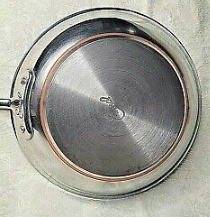
Clad construction
Consistent metal, induction friendly, quality 2.5 ml thickness is a good starting point.
Types of Pan Handles
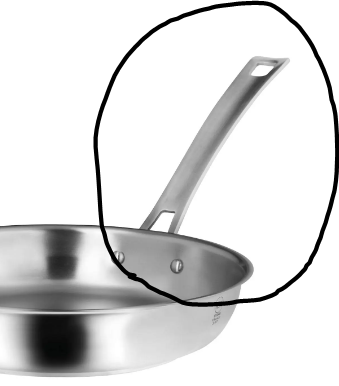
Riveted handle
Sturdy & reduces heat transfer.

Welded handle
Smoother finish, easy to clean, more hygienic.
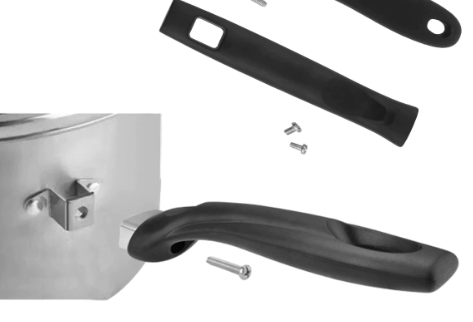
Screw handle
Budgeted cookware and potentially dangerous.
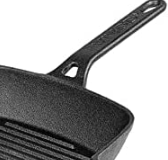
One piece handle
Seamless, ergonomic design, look for cutout vents that reduce heat transfer.
Silicon handles
Not always oven friendly, potential fire hazard.
Care & Maintenance of Your Pans
Safe vs Unsafe Cookware
When buying cookware you should use your own discretion regardless of claims made by the manufacturer. Our selection process consisted of a visit to the website of each and every manufacturer to learn how they went about addressing safety concerns surrounding harmful toxins found in metal cookware over the years. It’s important to educate yourself and have a functional understanding of how it all works.
With that being said we have listed potential dangers found in different metals in their natural state. This isn’t to suggest that manufacturers haven’t taken great steps in correcting the problem, but you should always know of the possible dangers inherent in certain materials as it pertains to the human body. Initiatives such as the “PFOA Stewardship Program” was launched to force a change that would prevent the inclusion of PFOA in the production of Teflon.
Toxic Cookware
Safe Cookware
The following cookware items are 100% safe…
Conclusion
When it comes to pans for cooking fish you should always consider safety first. Depending on how you prefer your fish cooked should determine which pan you choose. I personally like my fish a little crispy on the outside, and therefore my number one go-to is cast iron. I’m also mindful of the fact that real cast iron doesn’t carry any harmful toxins, although as a man I must remember that using cast iron too often can result in iron-toxicity. Whichever option you choose I hope it serves you well in every way, and I wish you the best of luck!
*Affiliate links may be included – if you click on affiliate links and sign up for the products and services trusted and recommended by Huddle Box, we will earn a commission.

